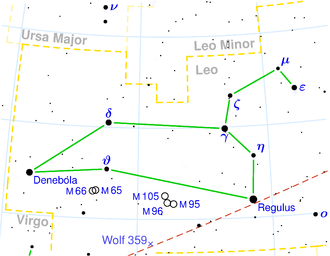NGC 3209
| Galaxy NGC 3209 |
|
|---|---|

|
|
| SDSS recording | |
| AladinLite | |
| Constellation | lion |
|
Position equinox : J2000.0 , epoch : J2000.0 |
|
| Right ascension | 10 h 20 m 38.4 s |
| declination | + 25 ° 30 ′ 18 ″ |
| Appearance | |
| Morphological type | E / PAS |
| Brightness (visual) | 12.7 mag |
| Brightness (B-band) | 13.7 mag |
| Angular expansion | 1.3 ′ × 1.1 ′ |
| Position angle | 80 ° |
| Surface brightness | 13.2 mag / arcmin² |
| Physical data | |
| Redshift | 0.020941 ± 0.000067 |
| Radial velocity | 6278 ± 20 km / s |
|
Stroke distance v rad / H 0 |
(278 ± 20) x 10 6 ly (85.2 ± 6.0) Mpc |
| history | |
| discovery | John Herschel |
| Discovery date | February 19, 1827 |
| Catalog names | |
| NGC 3209 • UGC 5584 • PGC 30242 • CGCG 124-003 • MCG + 04-25-002 • 2MASX J10203840 + 2530177 • GALEX ASC J102038.40 + 253018.8 • LDCE 721 NED002 | |
NGC 3209 is an elliptical galaxy from the Hubble type E2 in Leo on the ecliptic . It is an estimated 278 million light years away from the Milky Way and has a diameter of about 105,000 ly.
In the same area of the sky is the galaxy IC 2567 .
The object was discovered by John Herschel on February 19, 1827 .
